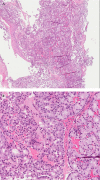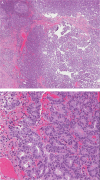Nasopharyngeal non-intestinal-type adenocarcinoma: a case report and updated review of the literature
- PMID: 28270733
- PMCID: PMC5330639
- DOI: 10.3747/co.24.3299
Nasopharyngeal non-intestinal-type adenocarcinoma: a case report and updated review of the literature
Abstract
Background: Non-intestinal-type adenocarcinoma is a malignancy traditionally found in the sinonasal cavity. To our knowledge, this case is the first reported of this rare condition originating in the nasopharynx.
Case presentation: A 67-year-old woman with nasopharyngeal non-intestinal-type adenocarcinoma, with an accompanying parapharyngeal mass received primary radiation treatment for both lesions. Her tumour subsequently persisted, with a concomitant conversion in pathology from a low- to a high-grade malignancy.
Results: Non-intestinal-type and intestinal-type adenocarcinomas of the nasopharynx are extremely rare tumours and do not appear in the World Health Organization classification system. We review the pathophysiologic features of these malignancies and propose modifications to the current classification system.
Conclusions: Non-intestinal-type adenocarcinoma should be included in the differential diagnosis of nasopharyngeal masses. In our experience, this tumour in this location showed a partial response to primary radiation but later converted from a low- to a high-grade adenocarcinoma.
Keywords: Non-intestinal adenocarcinoma; disease classifications; intestinal adenocarcinoma; nasopharynx; sinonasal cavity.
Figures





References
-
- Chan JKC, Bray F, McCarron P, et al. Tumours of the nasopharynx: nasopharyngeal carcinoma. In: Barnes EL, Eveson JW, Reichart P, et al., editors. Pathology and Genetics of Head and Neck Tumours: World Health Organization Classification of Tumours. Lyon, France: iarc Press; 2005. pp. 85–97.
-
- Barnes L, Tse LLY, Hunt JL, Brandwein-Gensler M, Curtin HD, Boffetta P. Chapter 1 Tumours of the nasal cavity and paranasal sinuses. In: Barnes EL, Eveson JW, Reichart P, et al., editors. Pathology and Genetics of Head and Neck Tumours: World Health Organization Classification of Tumours. Lyon, France: iarc Press; 2005. pp. 9–80.
-
- Bayrak R, Haltas H, Yenidunya S. The value of cdx2 and cytokeratins 7 and 20 expression in differentiating colorectal adenocarcinomas from extraintestinal gastrointestinal adenocarcinomas: cytokeratin 7−/20+ phenotype is more specific than cdx2 antibody. Diagn Pathol. 2012;7:9. doi: 10.1186/1746-1596-7-9. - DOI - PMC - PubMed
LinkOut - more resources
Full Text Sources
Other Literature Sources

